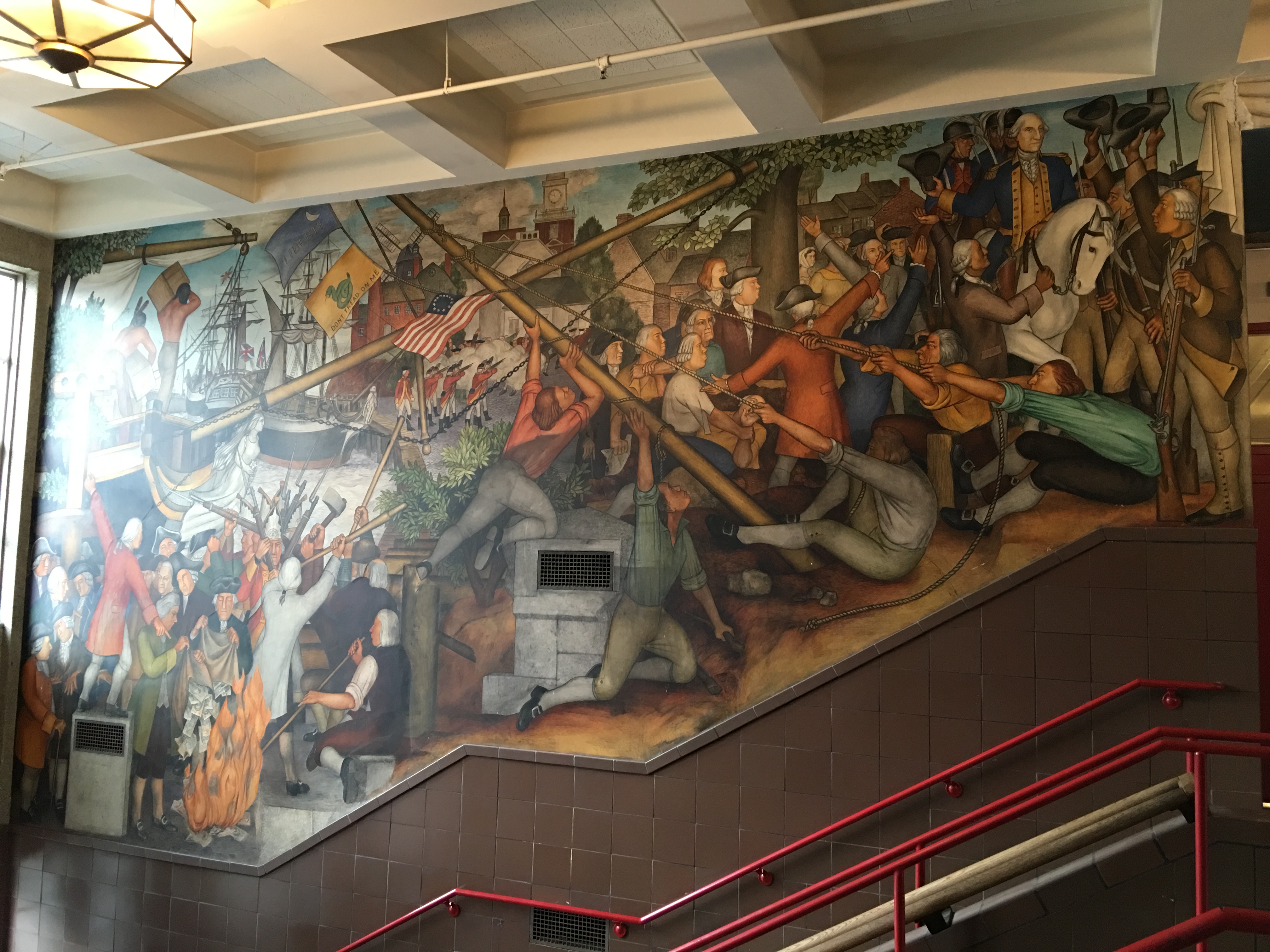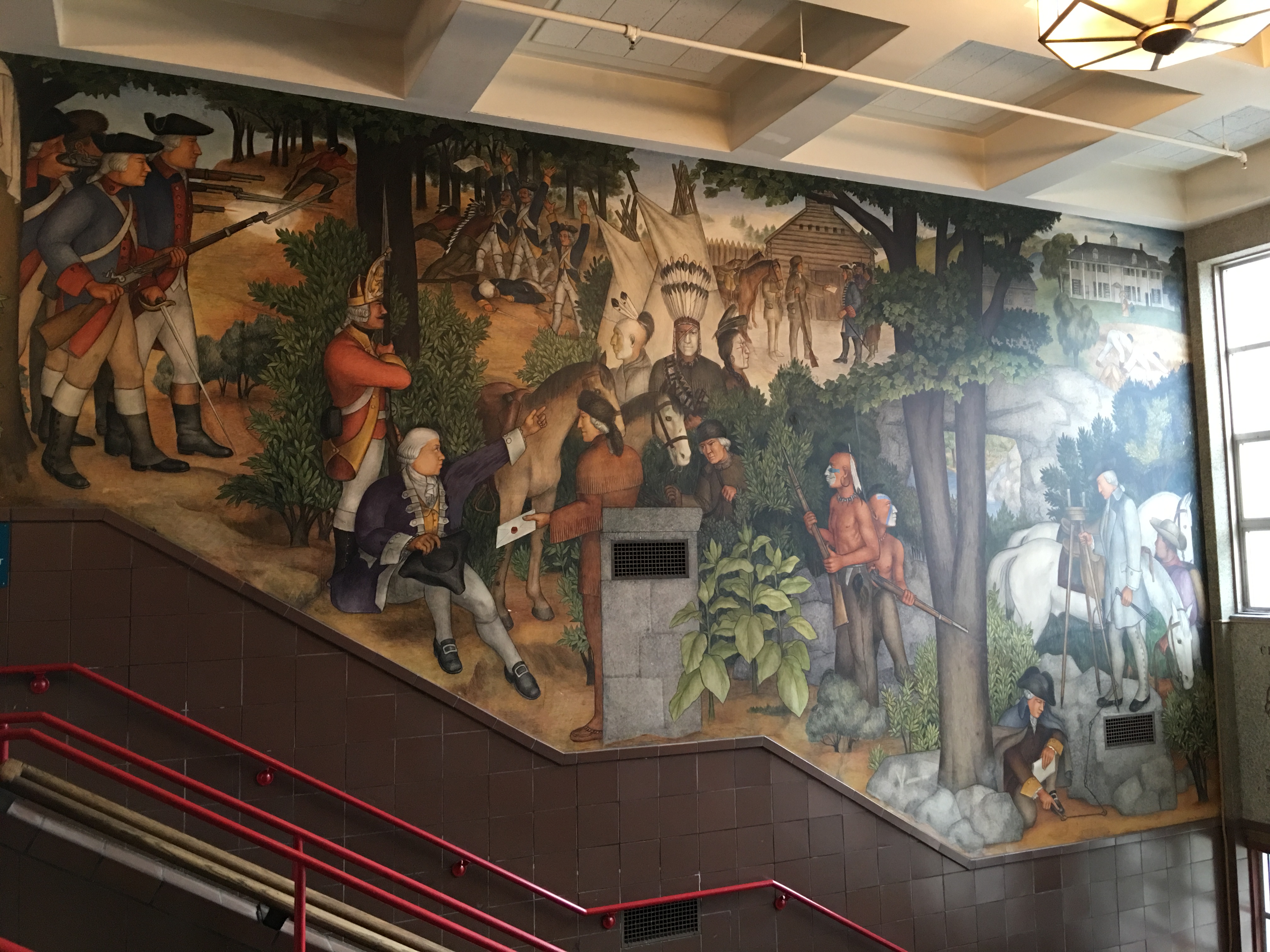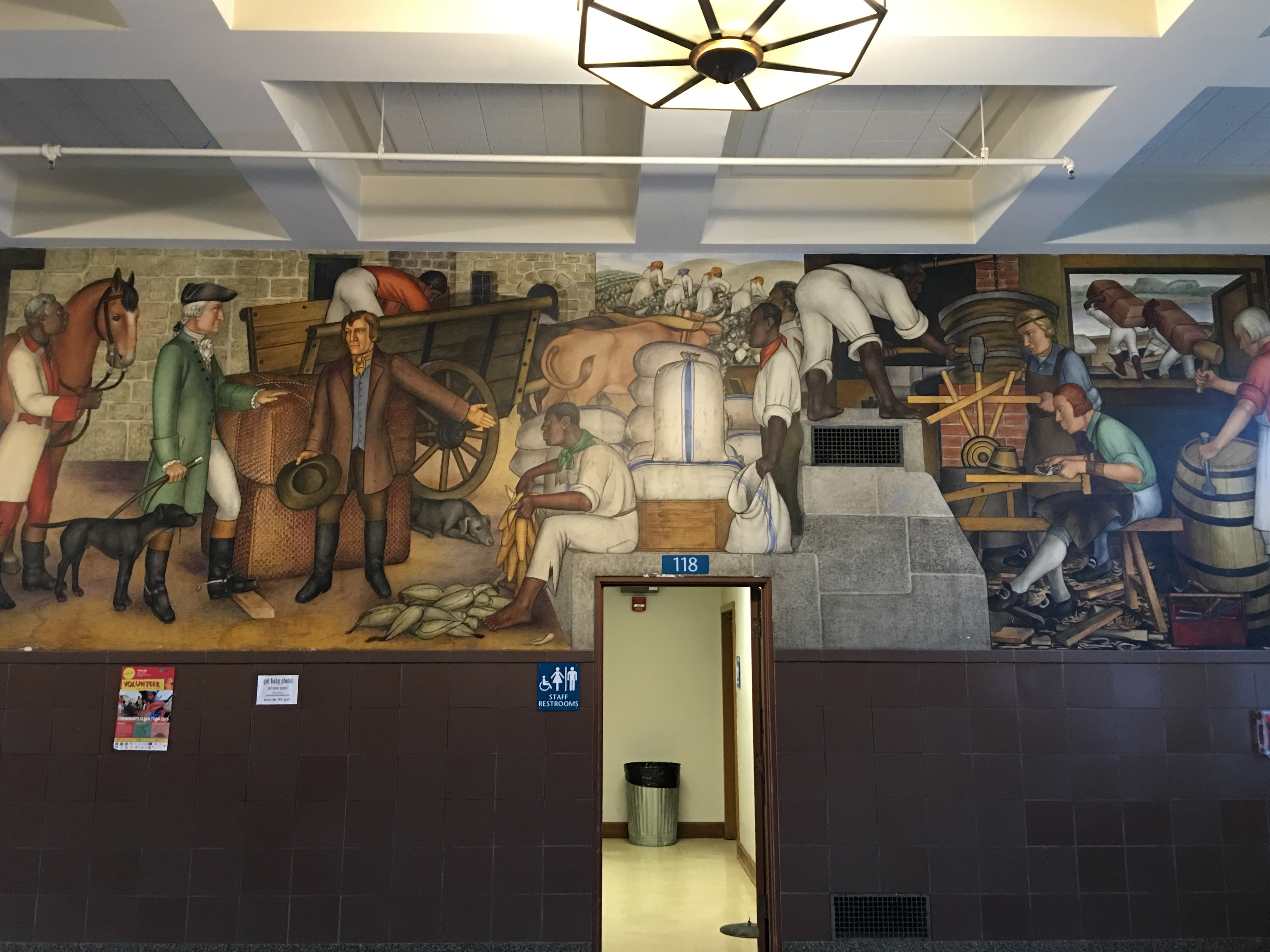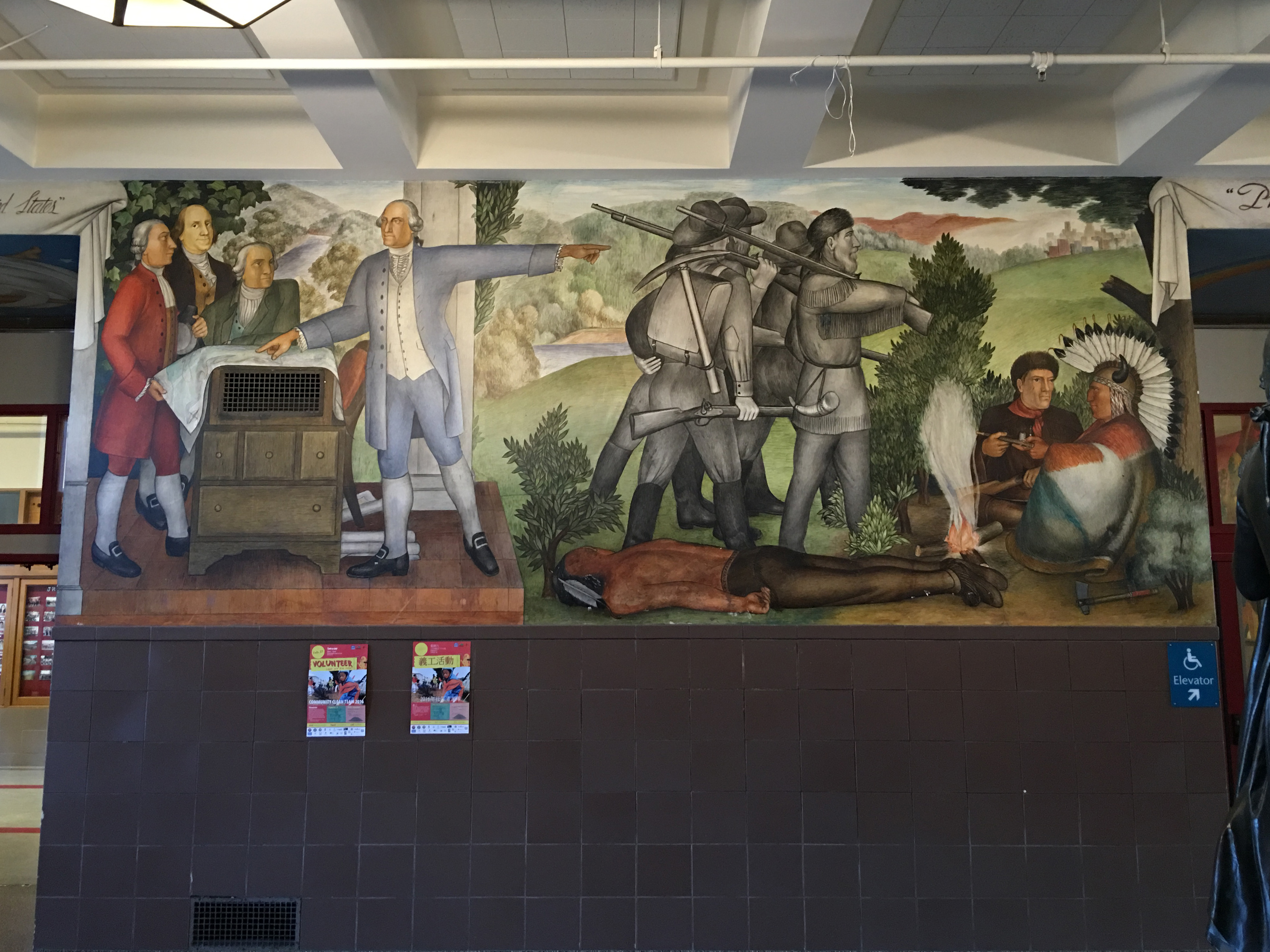By Mya Dosch
Public art—and its role in upholding white supremacy—continues to capture public attention in the post-Charlottesville United States. This year, the San Francisco Board of Education debated the fate of the 1936 Life of George Washington murals by Victor Arnautoff (1896-1979) in the stairwell and lobby of that city’s George Washington High School. Community members spoke out against the mural cycle for its depiction of a dead Native American; another Native figure holding scalps; and several enslaved African Americans. Many in favor of the murals’ removal used the hashtag #paintitdown, a clear reference to #takeemdown and Take ‘em Down NOLA’s work to remove Confederate statuary. Others declared that the murals should remain as significant historical artworks. Some argued that, by showing Washington as a slaveholder complicit in indigenous genocide, Arnautoff offered an antidote to the heroic “founding fathers” mythology. After contentious hearings, the San Francisco Board of Education voted in June 2019 to paint over the murals. Two months later, they revised their decision, opting to conceal the murals instead of painting over them.

Art history classrooms should be grounds where students engage with these most current debates over the role of public art. In her recent New York Review of Books Daily article on the controversy, art historian Michele Bogart rightly encourages us, as college instructors, to pose weighty questions about the Arnautoff murals to our students: “Who decides what is legitimate civic art in 2020, especially when it’s intended for minors? . . . How should we weigh competing claims based on different periods’ historical perspectives? When is it permissible or advisable to use censorship?” Each of these lines of inquiry could foster deep conversations on the Arnautoff murals.
However, Bogart also suggests that we ask our students, “Should personal feelings take priority over historical and educational group interests?” This presumes that reactions of community members who are against the mural, and particularly the people of color and indigenous people who have been central to the #paintitdown activism, are the sensitivities of individuals. In contrast, it implicitly frames the (white supremacist) status quo as “historical and educational group interests.” This denies the fact that all reactions to the murals are grounded in an individual’s various group identities, emotions, and understandings of history.
Bogart goes on to state that, “Teachers might also work to help students learn to distinguish between reacting subjectively to art work and exploring dispassionately the complicated historical reasons for what it depicts.” The idea that emotional reaction can be fully uncoupled from scholarly discourse is firmly embedded in an academic culture that values “self-regulation.” Yet at its worst, this ideal of emotionless discourse can serve as a sort of gaslighting. Acting as if a charged issue can be addressed without emotion may lead those students who have any strong reactions to a given work of art—from righteous anger to sadness, despair, excitement, or confusion—feel as if their gut feelings are aberrant and invalid. This distancing of emotion in the classroom has long been critiqued by feminist educators such as bell hooks, Megan Boler, and Alison Jaggar.* Analysis is always intertwined with our emotional, bodily, visceral reactions to concepts. As John R. Swallow suggests, “to expect that human interaction on deeply meaningful topics—race, mental health, assault, or other sensitive issues—can rely solely on rational argument is irrational.” In short, if we want to engage with consequential questions in the classroom, we must also acknowledge emotion. It is not a hindrance to productive classroom discussion, but instead central to it.

Opening classroom space for emotions about controversial artworks, is admittedly daunting. What if the conversation breaks into a shouting match with students personally attacking each other? What if a student starts crying during class? Of course, these reactions are not completely avoidable, but they are also teachable.
Here, I outline an activity for two or three class sessions (approximately three hours) on the Arnautoff murals that aims to both address the complexity of recent debates and create space for dialogue across differing opinions. It also addresses students’ affective responses. I draw from the ideas of other college educators such as Christy Wenger, who shows that emotional work in the classroom can be not only therapeutic, but also hermeneutic—that is, a central part of analysis.
The lesson would fit well in a course on U.S. art, as it highlights the contemporary significance of themes often covered earlier in the U.S. art survey: indigenous representation, slavery in art, and WPA murals. It could also follow a lesson on Richard Serra’s Tilted Arc (1981) in a Modern art or public art course, as it raises similar questions about the removal of artworks after public outcry. The structure is very loosely based on the application activities used in Team-Based Learning, during which teams take on the same significant task. Then, each team proposes and defends their solution.
Setting the Tone
Well before the Arnautoff lesson—usually during the first week of class—I invite students to crowd-source a list of classroom discussion guidelines. I often complete this as a “think-pair-share” activity. Students first write their thoughts in response to the prompt “what has made for good discussion in your other classes? How can we encourage this type of discussion? What made for frustrating discussions in other classes? How can we prevent this?” They then discuss their ideas with a peer, and lastly share back to the class. The list of guidelines that students generate becomes part of the syllabus and is posted on the course website. I remind students of these parameters regularly when we are about to embark on discussion.
Class 1: Visual Analysis and Reflection
To begin the Arnautoff lesson itself, I task students with looking at the Life of George Washington murals closely. This visual analysis activity helps students to engage with the murals’ imagery before reading the competing opinions on their content. In the process of completing this activity, students form their own opinions about the mural series. These opinions can then be challenged upon learning more about the history and controversy surrounding the murals, a key component in transformational learning experiences.
I divide students into teams of 4-5, giving each team three key questions to work on:
What are the messages about George Washington?
What are the messages about Indigenous/Native peoples?
What are the messages about African Americans?

For each question, teams need to justify their assertions with specific visual details. Each team begins with 15 minutes to look closely at print-outs of the mural panels (or, if possible, images of the murals loaded on tablets) and discuss the representation of each figure. Then, they are charged with creating three posters conveying their findings. The posters need to include a few words to succinctly summarize the messages, based on their analysis, and then highlight details that support their arguments. Students can collage printed images from the murals onto their poster to help make their points.
Once the posters are complete, students complete a “gallery walk,” reviewing all of the posters. Each person is given two sticky notes—one green and one pink. Students attach their green sticky note to a poster with a “persuasive idea”—adhering it next to visual analysis that they found compelling or had not thought of themselves, and writing a sentence or two about their reaction on the note. They attach the pink sticky note to an “unconvincing idea:” an interpretation that they disagree with, and similarly noting why they are doubtful. To wrap up the activity, teams reclaim their posters and look over the feedback. As a class, we discuss some of the key themes that arose from all posters, and come up with a list of the messages about George Washington/the Indigenous/African Americans as a class.
At the end of this class session, I hand out index cards and ask students to write two to three sentences reflecting on their emotional responses after these initial activities. “How do you feel after looking at these murals? What do you walk out of class thinking or feeling that you didn’t walk in with?” If there is time (and the class is not too large), I collect the index cards, shuffle them, and pass them back out to students. We then go around and read them aloud, to get an anonymous litmus test of the feelings in the room. If there is not time, I compile the responses and hand them out at the beginning of the next class. The students’ varied reactions serve as a jumping-off point to frame the readings for the next class and for the passionate feelings that they will encounter on either side of the debate.
Homework
For the next class session, I assign readings from authors on both sides of the debate and ask students to complete a “homework reading chart.” They list, in their own words, all of the arguments they can glean both for and against the murals’ continued presence at George Washington High School. The readings include Michele Bogart’s above-mentioned text “The Problem With Cancelling the Arnautoff Murals” paired with writer Jennifer Wilson’s essay in The Nation, “Black People Don’t Need Murals to Remember Injustice.” Should a shorter reading assignment be required, this KQED radio story by arts writer Sam Lefebvre succinctly outlines both sides of the argument. These essays could be supplemented by contrasting videos released by the two factions: Prof. Dewey Crumpler, who defends the Life of George Washington mural in light of the series he created for George Washington High School in 1976, and Amy Anderson, an indigenous parent, who situates the murals in the context of U.S. indigenous history.
Classes 2 and 3: Reflection and Board of Education Roleplay

At the beginning of the next class, we compile the students’ homework charts into two large lists on the whiteboard: arguments for and against the murals. I facilitate a discussion of the various underlying assumptions that motivate the specific arguments: for example, a desire for education, justice, belonging, or tradition. We also discuss the emotions that might be associated with key arguments—pride, anger, righteousness—and write these notes on the board alongside specific arguments. This section of the activity is not an afterthought, as students will need to recognize and negotiate these emotions as hypothetical San Francisco Board of Education Members in the next activity.
After laying out the contours of the debate, students return to their teams. Each “Board of Education” has to come up with a proposal that addresses what they feel are the most important considerations, as well as the emotions involved in the debate. I help the “Boards” through this process by first asking students to individually select three arguments from our list that they find most important or pressing. Students then discuss these in their groups. I encourage groups to come up with creative plans to address the conflicting contours of the debate.
Once groups have settled on a serviceable plan, half of the team outlines three key arguments in favor of their plan, highlighting how their ideas best address the needs—educational, emotional, and otherwise—of the community. The other half of the group identifies three potential arguments against their own plan, and prepares responses. At the end of class (or the beginning of the next session), each team presents a formal statement briefly outlining their solution and anticipating counterarguments. If there is time, I also facilitate a question and answer session on the designs. Each student anonymously votes for the other team that most convincingly laid out a nuanced argument, addressing community concerns. We conclude with a class reflection about the unexpected challenges of the process. If desired, this lesson could also lead to an individual writing assignment where students defend their own personal opinion about the fate of the Life of George Washington murals, drawing from everything they learned from the unit.
Learning outcomes and applicability
The project teaches students to engage with and negotiate diametrically opposed viewpoints about public art, while offering a structured framework for such discussion. Yet it also teaches the importance of acknowledging and addressing the emotional charge of these debates. As such, the lesson outline could also be adapted to other recent public art controversies: for example, the Early Days statue in San Francisco (Frank Happersberger, 1894) or the 2019 Milwaukee County transit murals by local teenagers that depict U.S. Immigration and Customs Enforcement deportations. The lesson teaches emotional intelligence, both overtly, through reflection on stakeholders’ conflicting emotions, and through the teamwork component, which requires students to build consensus on a charged issue. Collaboration on emotionally-weighty topics is a vital skill that all students could take away from an art history class, whether they recall the Arnautoff controversy or not.
* Megan Boler, Feeling Power: Emotions and Education (New York: Routledge, 1999); bell hooks, Teaching Community: A Pedagogy of Hope (Routledge, 2003); Alison M. Jaggar, "Love and Knowledge: Emotion in Feminist Epistemology," Inquiry: An Interdisciplinary Journal of Philosophy 32, no. 2 (1989).
Mya Dosch is Assistant Professor of Art of the Americas at California State University-Sacramento, where she teaches courses on public art, race and representation, and Latin American and Latinx Art. Her research focuses on art and urban space in post-1968 Mexico City, from monuments to protest interventions.



